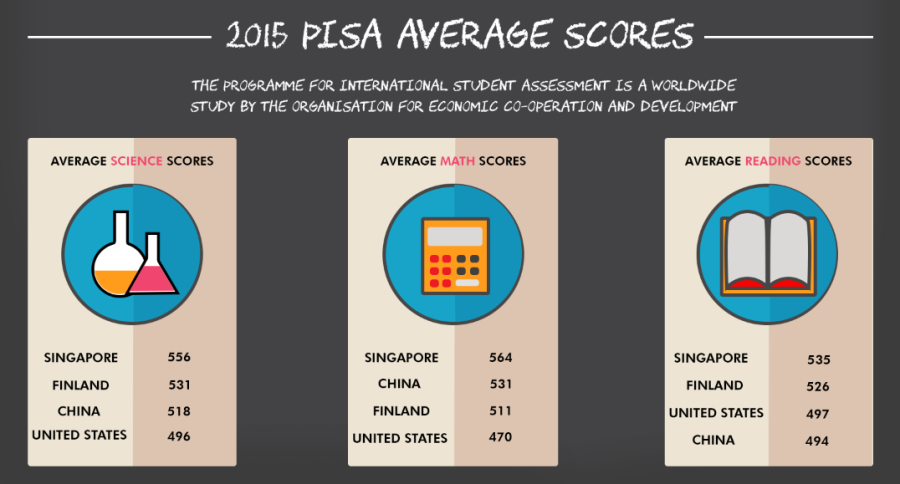Putting grading systems to the test
Examining the different methods teachers use to evaluate students
December 12, 2018
Grading systems take on different forms from classroom to classroom. The history of grading systems, as well as differing views on varied approaches to grading, can offer valuable insight into their benefits and their flaws.
Understanding the roots of grading systems allows students to better comprehend their schools’ and teachers’ grading systems. The modern-day notion of letter grades, as well as the notorious four-point GPA grading scale, found its origin at Yale University in the 1800s. A professor at the university began rating his students in order of predicted success, which caught on quickly and was soon implemented in schools across the country. Most modern-day schools have adopted this grading scale.
The FUHSD has a grading system that differs from that of many other districts in that it does not calculate weighted GPAs or give students class rankings. Some students prefer this system over others because they often have more to offer than is revealed by academic ranking. Furthermore, class rankings put a number of talented students at a disadvantage during college admissions as some students place more focus on non-academic areas and could discourage these students from applying to competitive colleges. According to a 2016 University of Chicago study, class rank does affect students’ performance and persistence in college.

“From a counseling perspective I actually appreciate that we don’t participate in individual ranking because I wouldn’t want anyone to think of themselves as a number. We do provide good information about where you stand in terms of comparison to the class without assigning that number,” said counselor Shana Howden. “I’m fairly in favor of the district not weighting GPAs. There are many colleges out there that don’t use a weighted GPA, so that information is not necessarily very helpful to students anyway. I don’t know that a weighted GPA tells you that much more than that student took additional advanced coursework, but if you’re a strong student, you’re a strong student.”
Other school districts such as the Palo Alto Unified School District (PAUSD) have chosen to utilize different grading systems. The PAUSD, unlike the FUHSD, weights GPAs. Weighted GPAs are part of a system in which classes with greater levels of difficulty, such as AP, Honors and IB courses, earn a student more points, which contributes to GPAs higher than the traditional four-point maximum.
In addition to districts’ systems differing, grading systems can also differ within each school. Just at Lynbrook, many teachers take on their own methods of grading. One defining aspect is whether teachers decide to separate their assignments into weighted categories or determine grades through total points. Other teachers, such as English teacher Erin Levin, chose to forgo giving points altogether.
“Although the standard point system is helpful in grade calculation, it can often be highly subjective,” Levin said. “Why should one assignment be worth five points while another is worth 30? I wanted to tackle this subjectivity when I structured my own grading system such that it helped my students do their own personal best without being held back by previous errors.”
International schools also have their own unique grading systems. Schools in India, South Korea and China place an emphasis on utilizing test-taking ability to determine one’s class rank and corresponding letter grade. In fact, some schools in these countries give overall grades solely on the basis of a single final exam.
“In my school in Hyderabad, [India], only a few tests mattered for our grade,” said junior Sindhura Vuppu, who moved from India in 2017. “The system in the U.S. is much more forgiving because you get graded on things like participation on a daily basis. But it also forces you to be more consistent with your work.”
In contrast, in some countries such as Finland, grading is considered more holistic than it is in the U.S.; students are evaluated on their ability to think creatively both in and out of a traditional classroom setting. Extracurricular activities and personal pursuits are heavily emphasized, and academic learning encompasses hands-on activities rather than traditional textbook learning.
While to some, it may seem that such an academically lax grading system could cause students to lose motivation in class, studies have proven the opposite. As stated by the World Economic Forum, Finland is consistently ranked as one of the top educational systems, and Finnish students tend to score exceptionally well on standardized testing compared to students of other countries, generally outperforming them in several measures of innovative thinking. The results of the 2015 Programme for International Student Assessment (PISA), an international standardized performance test taken by students in 65 countries, showed that Finnish students scored 531 points on the main section of the test, much higher than the global average of 493 points. The success of Finland’s grading system has been backed by the Ministry of Education and Culture’s studies, suggesting that an increase in freedom and focus on real-life problems as opposed to concrete evaluations such as tests, quizzes and homework in the U.S. play a large role in Finnish students’ high performance. While a decreased emphasis on academics may be a drawback for some, results show that this may be, in fact, a more effective grading system.
“When I attended school in Prague, tests in general, such as the SAT or the ACT, were irrelevant in the classroom context,” said junior Sofia Ermakova, who attended school in the Czech Republic until she moved to the FUHSD several years ago. “We never got numerical GPAs or letter grades. There was a lot of emphasis on learning at your own pace, and there was a heavy emphasis on developing character and discipline.”
At the end of the day, despite their varying forms in other districts and countries, each grading system comes with its pros and cons, as well as the intention of allowing students to be aware of their progress and reflect on their learning over the course of the school year.





























































